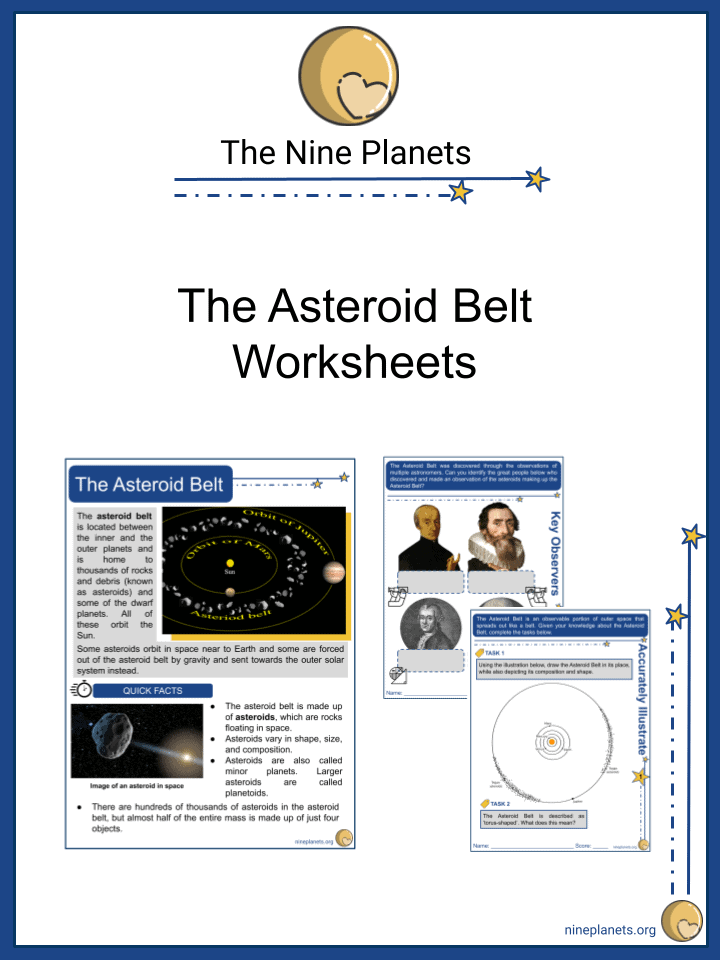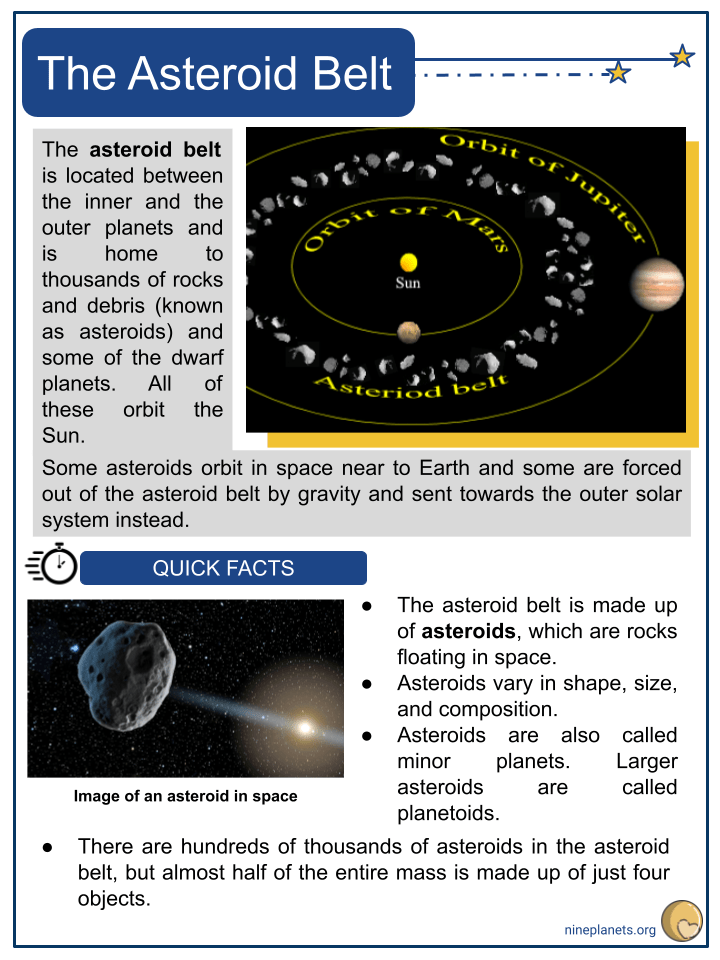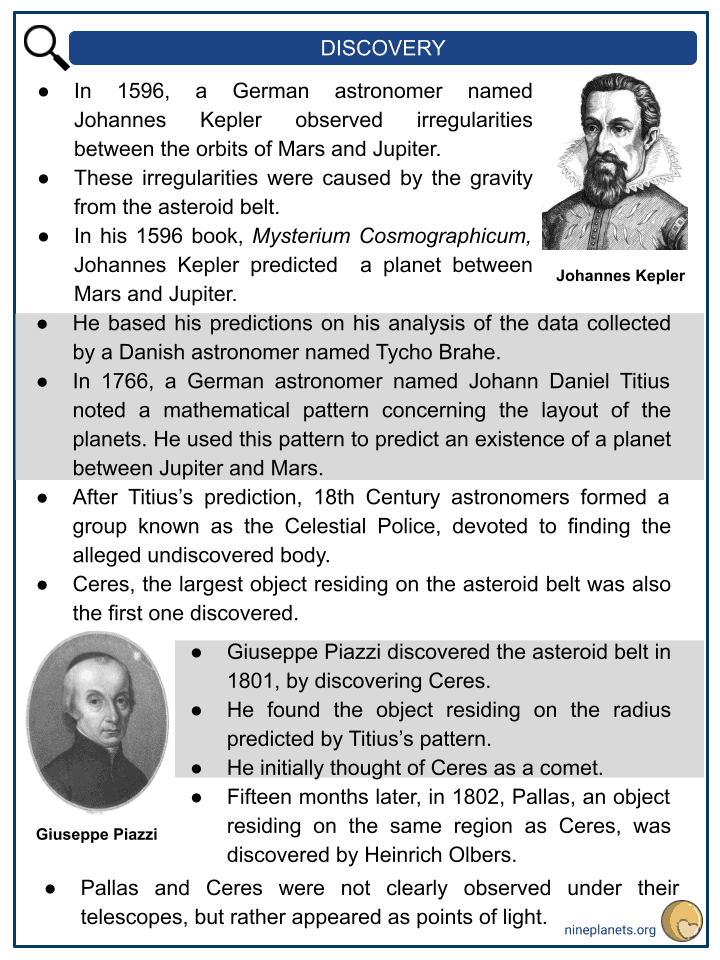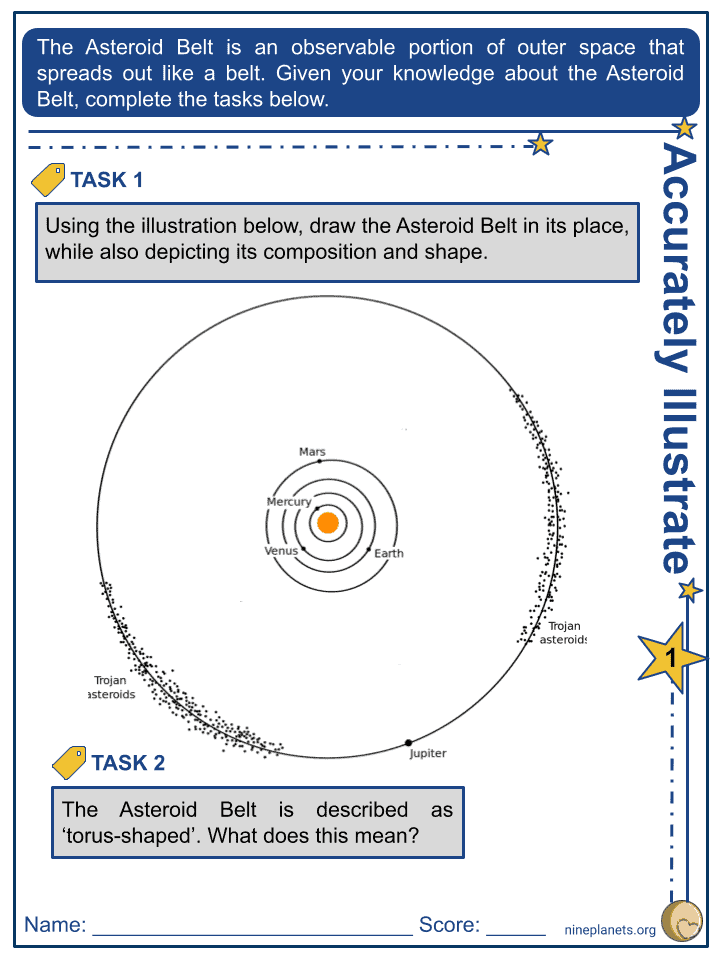Download The Asteroid Belt Worksheets
Click the button below to get instant access to these premium worksheets for use in the classroom or at a home.

This worksheet can be edited by Premium members using the free Google Slides online software. Click the Edit button above to get started.
Download free sample
Not ready to purchase a subscription yet? Click here to download a FREE sample of this worksheet pack.
Resource Examples
Click any of the example images below to view a larger version.




Key Facts & Information
- The asteroid belt is located between the inner and the outer planets and is home to thousands of rocks and debris (known as asteroids) and some of the dwarf planets. All of these orbit the Sun.
- Some asteroids orbit in space near to Earth and some are forced out of the asteroid belt by gravity and sent towards the outer solar system instead.
Quick Facts
- The asteroid belt is made up of asteroids, which are rocks floating in space.
- Asteroids vary in shape, size, and composition.
- Asteroids are also called minor planets. Larger asteroids are called planetoids.
- There are hundreds of thousands of asteroids in the asteroid belt, but almost half of the entire mass is made up of just four objects.
- These objects are the dwarf planet Ceres, and three other asteroids called Vesta, Pallas and Hygiea.
- The diameters of Vesta, Pallas and Hygiea are over 400 kilometers and Ceres is even bigger at 950 kilometers in diameter.
- Of the many thousands of asteroids in the asteroid belt, Ceres is the only one large enough to be classified as a “dwarf planet”.
- Apart from these four objects, the remaining objects in the asteroid belt range in size from small rocks right down to dust particles.
Location And Distance
- The asteroid belt is between the planets Mars and Jupiter.
- It is located about 2.2 to 3.2 Astronomical Units (AU) from the Sun. That is somewhere between 329-478 million kilometers away.
- The asteroid belt is huge and the space between each of the asteroids is over 600,000 miles.
- The circumference of Earth is only 24,901.45 miles, which means that the distance between objects in the asteroid belt is more than 24 times the circumference of Earth.
Discovery
- In 1596, a German astronomer named Johannes Kepler observed irregularities between the orbits of Mars and Jupiter.
- These irregularities were caused by the gravity from the asteroid belt.
- In his 1596 book, Mysterium Cosmographicum, Johannes Kepler predicted a planet between Mars and Jupiter.
- He based his predictions on his analysis of the data collected by a Danish astronomer named Tycho Brahe.
- In 1766, a German astronomer named Johann Daniel Titius noted a mathematical pattern concerning the layout of the planets. He used this pattern to predict an existence of a planet between Jupiter and Mars.
- After Titius’s prediction, 18th Century astronomers formed a group known as the Celestial Police, devoted to finding the alleged undiscovered body.
- Ceres, the largest object residing on the asteroid belt was also the first one discovered.
- Giuseppe Piazzi discovered the asteroid belt in 1801, by discovering Ceres.
- He found the object residing on the radius predicted by Titius’s pattern.
- He initially thought of Ceres as a comet.
- Fifteen months later, in 1802, Pallas, an object residing on the same region as Ceres, was discovered by Heinrich Olbers.
- Pallas and Ceres were not clearly observed under their telescopes, but rather appeared as points of light.
- In 1802, William Herschel suggested that these objects be classified in a separate category called asteroids.
- The name “asteroid” is derived from the Greek word “asteroides”, which means “star-like”.
- Over the next few decades more objects were found and in the 1850s astronomers began calling the region “the asteroid belt”.
- Juno and Vesta were discovered lying in the same region in 1807.
- The fifth object, Astraea, was discovered in 1845.
- By the year 2000 over 100,000 asteroids had been discovered.
Formation
- Particles of rocks and dust that orbited the Sun were pulled together by gravity.
- Some particles were pulled together to be large enough to form a planet, just like the Earth.
- Some were not large enough, and so they were asteroids, or minor planets instead.
- A region between the orbits of Jupiter and Mars formed into a region circled with these asteroids, and so an asteroid belt existed.
- Over the years, astronomers speculated whether the asteroid belt was a remnant of a destroyed planet.
- However, according to NASA, the total mass of the asteroid belt does not even equate to the mass of the moon. Therefore, the asteroid belt does not weigh enough to form a planet.
- In 2018, research done at the University of Florida found out that the asteroid belt was made up of remnants not of only one planet, but of several ancient planets.
Evolution
- It is believed that the current asteroid belt only contains a small portion of the original asteroid belt.
- According to computer simulations, the mass of the original asteroid belt might equate to the mass of the Earth.
Orbits
- The asteroid belt is held by Jupiter’s gravity, thus keeping it from colliding with other planets.
- The majority of the asteroids residing in the asteroid belt have an orbital eccentricity of less than 0.4, and are inclined to a less than 30° angle.
- An asteroid in the asteroid belt usually has a relatively circular orbit and lies near the ecliptic plane. However, some asteroids could have a highly eccentric orbit and travel outside the ecliptic plane.
Size And Shape
- The asteroid belt is torus-shaped.
- In geometry, a torus is a surface of revolution generated by a circle in three-dimensional space coplanar with a circle.
- Therefore, the asteroid belt could be observed in the shape of a ring.
- The asteroid belt spreads out and circles widely like a belt.
- Many people picture the belt crowded with asteroids. However this is not the case. The asteroid belt is so vast that the objects are widely spread out, in fact spacecraft have managed to easily travel through the belt without collision.
- The asteroids are all irregularly shaped.
- The size of the objects within the asteroid belt range from being as small as a dust particle to almost 1000 km wide.
- Large asteroids have a diameter greater than 150 miles.
Largest Objects
- The four largest objects in the belt are Ceres, Vesta, Pallas and Hygiea.
- These asteroids alone make up about half the mass of the asteroid belt.
- The largest is the dwarf planet Ceres. Ceres is the only dwarf planet in the asteroid belt.
- Vesta, Pallas, and Hygiea are the largest asteroids in the region, which measures up to 250 miles.
- Ceres, the dwarf planet located in the asteroid belt, measures 590 miles, or about a quarter of the Earth’s moon.
- Ceres is not large enough to be a planet, but it makes up a third of the asteroid belt’s mass.
Composition
- The majority of the asteroids located in the Main Asteroid Belt are composed of rock and stone, and a small portion of these asteroids contain iron and nickel.
- The remaining asteroids in the Main Asteroid Belt are also made of similar materials, but they are mixed with carbon-rich materials.
- Distant asteroids contain more ices.
- Asteroids are not large enough to generate and sustain an atmosphere. However, evidence shows that some asteroids contain water.
- The smallest asteroids form a pile of rubble held by gravity. They pile up into irregular shapes which often resemble a potato.
- An example of a small asteroid is the 216 Kleopatra, an asteroid that looks like a dog bone.
- Carbonaceous asteroids are asteroids rich in carbon, these objects dominate the outer region of the belt.
- S-type asteroids are silicate rich asteroids, and are common in the inner region of the belt.
- M-type asteroids or metal rich asteroids compose 10% of the asteroid belt.
- V-type asteroids are rare asteroids that contain basaltic minerals. This suggests that larger asteroids formed crusts or mantles.
- Most basaltic asteroids originated from the asteroid Vesta, hence the name, V-type.
Did You Know?
- Astronomers used to believe that the objects within the asteroid belt were the remnant of a planet smaller than Earth’s moon that had exploded. However this theory is now accepted to be untrue and it is thought the asteroids were never part of a planet.
- Gravitational forces can throw asteroids out of the belt and send them towards the inner solar system. Asteroids are similar to comets but lack the coma which appears as a tail.
- Sometimes the asteroid belt is called the main belt to help differentiate between other groups of asteroids in the solar system.